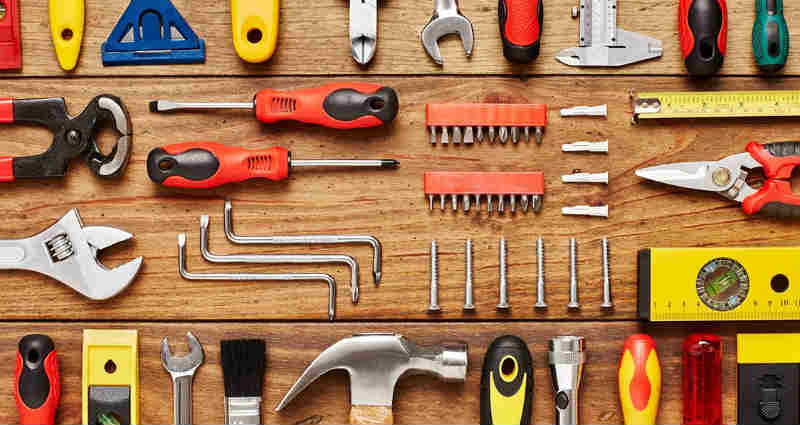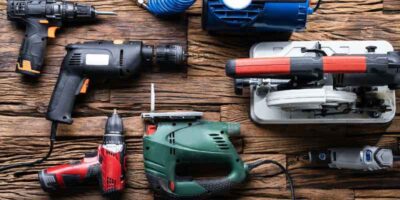A tool kit should remain in use for many years. Therefore, it is worthwhile to equip it with high-quality tools. The motto is: “Who buys cheap, buys twice”. Unfortunately, the quality can not be recognized either by detailed product descriptions or by material references such as “made of chrome-vanadium steel” or gloss. Even the price is limited. But if you pay attention to a few key details that we tell you here, you can not go wrong with the tool purchase and choose what is better in the hand. Or you choose a specific manufacturer and create a uniform set. This list is what you need in a basic tool kit.
What you need in a basic tool kit: the 14 essential tools
1. Screwdrivers
Without a good screwdriver set a do-it-yourselfer does not get by. This is the first tool to think of for what you need in a basic tool kit. It should be screwdrivers with the most important sizes and tips to be prepared for almost all screwdriving.
Slotted screwdrivers are only suitable for the conventional slotted screws. When using screwdrivers, always make sure that the tip or blade and the screw head fit together well.
For Phillips screws is even more true that blade tip and screw head must match. We recommend two screwdrivers each for Phillips and Pozidriv Phillips (in sizes 1 and 2). Pozidriv screws have an additional drive cross and are mainly used as chipboard screws.
Screwdrivers for larger Phillips screws and the increasingly used Torx screws are best bought as needed, as these will only be required for a few tasks.
Good two-component handles ensure better power transmission. A hexagonal blade or hex at the blade base for a wrench facilitates loosening tight screws.
2. Allen keys
The Allen key, also commonly called hex key, is also part of the basic equipment of every DIY enthusiast around the world and is required on the list of what you need in a basic tool kit. The hexagon bolt is used, for example, for fixed connections on the bicycle. Compared to a Phillips head screw, an allen can withstand ten times the torque .
Common Allen sizes are 2-10mm, most often you will need 4, 5 and 6mm. For these screw sizes, the purchase of the original Allen key would be worthwhile.
Although they are significantly higher in price than the simple models, but you also get a sophisticated design in a material quality that is second to none, ergonomic handles for optimum power transmission and a guarantee of ten years.
3. Wrenches
Wrenches are needed above all for loosening or tightening screws with hexagonal head and are among the most versatile tools of what you need in a basic tool kit. The basic equipment is a set with about eight to ten combi keys in sizes between 8 and 17 mm. Combination wrenches have a wrench end on one side and a ring spanner on the other, so you’re ready for any eventuality.
When buying a wrench, look for a known brand and go to your dealer. This is the best clue to avoid inferior cheap goods .
Do-it-yourselfers who want to work on bicycles or other specialist tasks can expand the basic set according to the special needs with open-end and ring spanners.
Ring wrenches with a corrugated profile grip the screw heads on the flanks and prevent the corners from being turned around, especially if the screws are very tight.
Professional screwdrivers also like to use socket sets. Pay particular attention to a high-quality ratchet, also called ratchet. Particularly robust are the simple ratchet with twelve teeth. However, more comfortable are those with switchable working direction, finer teeth, locking mechanism and additional joint.
4. Foxtail saw
The foxtail — also known as the dovetail saw — is a practical allround saw for the rough with usual blade lengths of about 35 to 50 cm. Simple fox tails usually have an open or closed wooden handle, but today many are also equipped with a plastic handle. There are multi-component handles that improve ergonomics and thus make work easier.
These are also offered especially for left-handers. With good fox tails you can change the saw blade and replace it with other saw blade types. The teeth of the foxtail saw blade are limited for better chip removal and cutting performance.
With good fox tails you can change the saw blade, and this is the kind to consider for what you need in a basic tool kit. With a carbide-tipped saw blade, the foxtail is then also suitable as a replacement for corresponding special saws for sawing aerated concrete bricks and other building materials.
Usually, boards, squared timbers or planks are cut with the foxtail. Once the saw has been cut into the material, it will guide itself through the wide saw blade, thus allowing straight cuts. With a corresponding guide, the foxtail can also be used for sawing miter cuts.
For finer wood cuts, however, a shorter saw with reinforced back and simple handle handle is needed. In combination with a miter box, it is also suitable for precise cuts of small skirting boards, picture frames and other wooden strips.
5. Side cutter
Unlike a pair of scissors, where the two cutting edges slide past each other, a side cutter cuts have a bite-cut like the good old pincers, which are also known as front cutters, and should definitely be on your list for what you need in a basic tool kit.
The two cutting edges of the side cutter hit each other directly and snap off wires or nails. Other materials such as rubber or plastic can be separated with a side cutter.
Especially for cutting iron and non-ferrous metals, the cutting edges of the side cutter must be hardened.
Inferior side cutters after cutting nails, for example, have nicks in the cutting edge. You should leave such products at the hardware store. Therefore, it is best to do the nail test before purchasing a side cutter. Depending on the material to be cut, the cutting edge may have a different angle.
The industry therefore also offers a number of special side cutters for special applications. For the use at home, however, the standard version is sufficient. So-called force side cutters have a different lever force ratio, which should allow for easier cutting.
Advantageous are thick handle covers made of plastic, which facilitate cutting. Handle lengths, grip distances and grip curves should be adjusted so that the hand in the moment of the highest power demand is the optimal leverage available.
6. Hammer
The hammer is a classic among the hand tools, and is crucial for any household considering what you need in a basic tool kit. The standard hammer with wooden handle or rubber-covered steel handle is the standard tool for hammering in nails and also for light chisel work.
Hammers with a head weight of about 300 g are suitable for most work in the house. For light work, for example, to insert wire pins for picture frames or other thin wooden strips, a second, smaller hammer weighing 100 g is recommended.
When buying a hammer, pay attention to a solid attachment of the handle in the eye of the hammer head. A clearly visible wedge sleeve is a quality feature. However, if the eye is covered with paint, caution is advised. Who knows what the manufacturer wants to hide underneath? High-quality hammers often have a handle sleeve, which additionally strengthens the connection between hammer head and handle.
In the piles of hardware stores and supermarket chains you will always find hammers where the head is already wobbling slightly.
Such dangerous products should be reported to the Trade Inspectorate, but at least to the market management, because if later when working with such a tool, the hammer head from the stem, it can be a lethal bullet.
7. Key pliers
Pliers multiply by their leverage the human force and are therefore good for gripping and holding different workpieces and screws. As a particularly useful pliers should not be missing in the household a pair of key pliers with parallel, smooth jaws.
It can be used for gentle screwing on chrome-plated fittings as well as a universal wrench replacement. The simple quick adjustment at the touch of a button makes it easy to set the distance between the jaws to the desired size.
Key pliers are available in different sizes. While the average size of 250 mm in length and a working area of up to 46 mm is best suited for household use, the purchase of a smaller version with a length of 180 mm and a maximum jaw distance of 35 mm is a practical tool for two-wheeled fans – motorized and non-motorized.
For adjustable pliers , make sure there is sufficient protection against pinching. The two handles must never be compressed so far that they can pinch the fingers, for example when slipping off a work piece.
8. Steel tape measure
A retractable tape , usually made of hardened spring steel or stainless steel, is another indispensable part in the workshop. Particularly common are steel tape measures in lengths between 2 and 5 m. Tape dimensions for outdoor use are also available with a length of up to 100 meters. In the steel tape dimensions, the tape is rolled up in a metal or plastic cassette. The scale is imprinted or even etched so that it can be easily read at any time, even when subjected to heavier loads.
The beginning of the band is usually provided with a small slider. This can be attached to the outside of the workpiece to be measured. For some tape measures it can be inserted for internal measurements. On the roller side, there are two readout levels for most belt dimensions. For simple distance measurements, the user reads the distance directly in front of the cassette. For indoor measurements where the length of the cassette is taken into account, the measured distance is often displayed in a window.
Steel strip dimensions usually correspond to accuracy class II (tolerance ± 1.1 mm at 3 m or ± 1.5 mm at 5 m). When buying, pay attention to the corresponding symbol (II) at the beginning of the volume. Incidentally, the known folding rules (folding rules) made of wood or plastic usually correspond only to the accuracy class III (the tolerance is ± 1.4 mm at 2 m).
9. Small hacksaw
Small hacksaws with replaceable saw blade, usually referred to as “Puk saw”, there are different versions with a simple wire hanger, with stronger handle and handle made of wood or plastic or with a handle that can be swung in the saw bow, called a pocket saw.
The saw blade is hung either by squeezing the strap or the strap is first relaxed by turning the handle before the saw blade can be hung. Try before buying, if you can deal with the saw blade change, usually the slightly more expensive saws are at an advantage here. These “mini saws” are used for work mainly in metal and plastic, more rarely in wood.
Nevertheless, with the fine-toothed saw blade practically all materials can be cut in the household, and for wood there are special saw blades. Unlike other hacksaws, this saw does not work on push but on pull. Therefore, the sharp teeth must always point to the handle.
If the approximately 15 cm saw blade length of the Puk saw is not sufficient, you should get a metal hacksaw that is not only longer, but also more powerful – equipped with special blades for different materials.
10. Combination pliers
As the name of the combination pliers suggests, this is a universal pliers that combines several functions. The combi pliers feature different gripping surfaces at the top and in the middle and also have a cutting edge for cutting off soft wires.
The combination pliers also holds nails when knocked into the wall, thus helping to avoid thick thumbs. Since combi pliers are very popular, especially in electrical work, they are often offered in tested VDE design and are then tested 10,000 volts.
But as a layman should keep his fingers off the electricity and dangerous electrical work, the money for a not too small brand pliers is better laid out. The quality of a combination pliers often shows in their cutting properties. Therefore, a simple cutting test on a soft steel wire can quickly separate the wheat from the chaff.
With a good combination pliers the wire should be easy to cut, and of course no nicks should remain in the cutting edge. Pay attention to the easy movement of the pliers when purchasing a pliers. Pliers should always be operated with one hand. Heavy-duty pliers that require both hands to open belong to the trash. Even for special applications, the industry’s offer is now so great that there is a special solution for almost every problem.
11. Spirit level
To determine and mark horizontal and vertical, a spirit level is the ideal measuring tool . It pays to spend the money on a high quality, at least 60 cm long spirit level.
Such spirit levels today usually have a body made of light metal or plastic. The standard spirit levels have two tubes for applying horizontal and vertical lines, some additionally at 45-degree angles.
The level tubes are the heart of the spirit level and also determine the quality. The weaker the curvature of the tubes, the easier the bubble moves from one side to the other. Only in absolutely horizontal position, the air bubble may be in the middle of the two markings on the dragonfly. Spirit levels are relatively easy to check. Place the spirit level on an approximately horizontal surface and look carefully at the position of the bubble in the bubble.
Now take the spirit level and turn it 180 degrees, so that the left side is now on the right. If the bubble is now back in the same place, the spirit level is okay.
12. Ratchet
A ratchet is the most important part in a socket set. You should pay close attention to this when purchasing. Particularly robust are the simple ratchet with through-square and twelve teeth.
More comfortable are those with switchable working direction and fine toothing. In any case, the quality must be right with these creaks, because otherwise the mechanism inside will give up the ghost first.
The appropriate size depends on the size of the nuts or the side of the square: for the screw sizes 4-14 1/4 “(inches) is the right choice, for 12-34 the 1/2” ratchet is suitable , Metal handles look sturdy, but with a non-slip grip it works better.
13. Cutting knife
A sharp blade is indispensable in the toolbox, so the cutter or utility knife is also standard equipment when you are looking at what you need in a basic tool kit. If the blade is worn, it can be gradually broken off and finally completely replaced.
The shaft will continue to be used. Shafts with fixed blades, which can be turned once before changing, are a second variant of the carpet knife.
As with so many tools, the one-euro offer in plastic, with only a metal guide rail for the blade, will certainly do its job a few times. For frequent use, even after years, it is best to create a cutter with metal housing and ergonomic handle.
14. Pocket knife
MacGyver always had it with him and it should be a constant companion for home improvement as well: the Swiss army knife. In addition to knives , screwdrivers, bottle openers and files, there are countless other functions and equipment variants.
The original is still of Swiss quality and is produced exclusively by two companies. Imitations are mostly made of inferior steel. However, there are also similarly equipped pocket knives from other brand manufacturers in comparable quality.
How to build a workshop tool wall
 Gerhardt Richter is a writer and a trainer at trade technical colleges, specializing in carpentry, plumbing, mechanics and construction.
Gerhardt Richter is a writer and a trainer at trade technical colleges, specializing in carpentry, plumbing, mechanics and construction.




